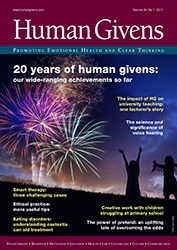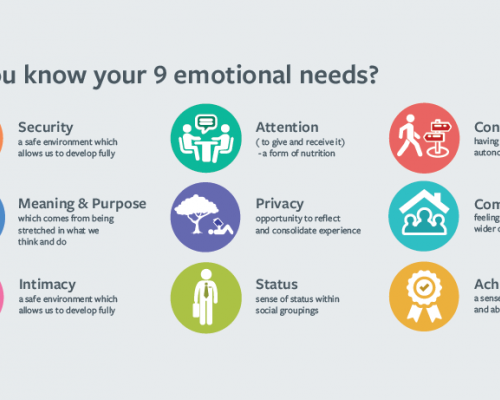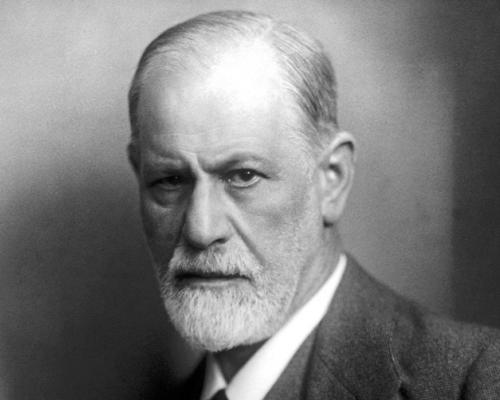Human givens and social work
Social work should be about helping people yet, bogged down in bureaucracy, it has lost its way. Jan Little shows how the human givens approach can put it back on track.
“It's performance management, these days.” “It’s crisis work.” “It’s case management — we don’t actually work with people any more.” “It’s all paperwork.” “It’s telling people what they can’t have.”
These were social workers’ responses when I asked them, at a training day, how they would define social work. But when I asked them why they had come into social work, they immediately replied, “To help people”. And then one added sheepishly, “But wasn’t that naïve!”
I don’t think it was naïve. For me, helping people is still what social work is all about, and unfortunately, under the burden of bureaucracy and paperwork, we’ve lost sight of the fact that ‘helping’ is the social work goal. I am not saying that social work is over-controlled. Indeed, I strongly believe that social work needs to be evidence based and accountable, which inevitably means a certain amount of record keeping. However, tickbox forms completed in duplicate may show we visited a particular family at a particular time and we actually saw the child in question, but they are absolutely no help in determining whether what we did on the visit was in any way effective.

The Department of Health’s new Assessment Framework for Children in Need 2000 looked as if it might be a step forward, providing, for the first time, a consistent approach to collating information and assessing families’ needs. The framework assesses the child’s developmental needs; the carers’ ability to parent and the needs of the family arising from poverty, poor housing, and other aspects of environment. All of this information is analysed and provides a sound basis for decision making and action.
However, completing the required assessment records entails making tickbox responses and, unfortunately, with tickbox tools, there is always the risk of their being misused and completed mechanically. Some social workers feel that completing the assessment records consumes too much time because so much information is required. This is particularly so in areas where the child care team may comprise only a couple of social workers, owing to difficulties in recruiting and retaining staff. We do need a consistent child focused framework for collecting information, but we don’t want it failing because of difficulties using it as intended.
The overall emphasis on performance management, monitored by targets and performance indicators etc. serves only to separate social work from its core function: to help. In fact, a problem being masked by the plethora of performance management data is that we aren’t at all clear about what we are trying to achieve by them. Performance indicators, such as how many children there are at any one time on the child protection register, are meaningless on their own. Similarly, targets are more likely to concern the completion of work within a certain time scale, rather than meeting a predetermined, highly specific and measurable outcome agreed in each individual case. For instance, all too often the ‘goal’ in child care is to ‘provide support’, instead of ‘providing support to achieve exactly what and how’.
What needs are not being met?
This is where the human givens approach can be so useful to social work, and I would like to see its adoption widely within it. It encompasses within a very simple framework the diversity of social dilemmas that human beings face: what needs are not being met?
We know that social workers are very often involved in helping people meet their basic physical needs — for sufficient food, for warmth, for a roof over their heads. Similarly, they have a role to play in helping people meet their emotional needs, which, if unmet, lead to stress and distress. It is probably universally accepted that all humans need love, intimacy and self-esteem — but these cannot be handed over on a plate.

However, the human givens model identifies other less well recognised emotional needs which can be worked with more directly and which, when fulfilled, automatically increase self esteem and the ability to love and be loved. These givens are the need to give and receive attention, the need for community or connection (beyond the immediate family), the need for autonomy or a degree of control, the need for purpose or meaning, and the need for flow (utter absorption in a worthwhile activity).
When I say to social workers, “For me, social work is about helping people to get their physical and emotional needs met”, they respond at once. It is as if, amid all the rushing about and form filling and working against the clock, they remember “Ah yes! That’s what I’m supposed to be doing all this for.” They can instantly see the relevance of the approach for tackling the problems of the people they work with.
A young person just taken into care, for instance, may well resort to negative behaviour in desperation to meet their need for attention (or, if they have been neglected at home, may have resorted to this already). They may well feel all meaning has been stripped from their lives, if they perceive themselves as rejected by their family and cut adrift, and may search to replace it through negative sources such as promiscuous sex, drugs or alcohol. They clearly lose community in the event of their sudden removal from the home where they lived and the connections they have made in their locality. They have no control over what has happened to them. And talents or interests which they previously enjoyed (flow) may somehow fall by the wayside in the transition from home to care.
When an individual’s position is viewed in this way, the question becomes “How can we get these needs met more positively, using the resources that the individual has?” The answers do not have to be very complicated.
The gymnast
In one care home, Conrad, a young man with mental health problems was discovered to have remarkable gymnastic abilities. That simple discovery and follow-through has led to all five of his emotional needs being met to some extent – and to a diminution of his psychological difficulties. The gymnastics class that he started to attend was in the community, instantly widening his horizons beyond the children’s unit where he lived. Quite quickly, he was helping the instructor in class, thus meeting his need for the giving and receiving of attention. As a result of all this, he had purpose in his life, regardless of whatever had happened within his family. And he had flow and a sense of control over his life again.

Angela, a young teenager taken into care, was found to have an ability to play the violin masterfully. It took a long time for this ability to emerge because, in the painful time of her move into care, she had become depressed and unmotivated. Although such an ability may eventually be noted in the records completed for children in care, applying the human givens framework as soon as a young person arrives in care, and keeping it always in mind, enables effective solutions to be reached and set in motion much more quickly. (Conrad and Angela were both truly gifted, but all young people have resources we can use, if we take the time to find them.)
No ‘experts’ needed
The simplicity of the human givens approach helps overcome social workers’ traditional fear that they aren’t ‘expert’ enough to offer counselling. Social work training may cover psychodynamic, humanistic and ecological systems, and cognitive models of assessment and intervention. This may give social workers the impression that any counselling needed should be in-depth and relatively long term. (In fact, this is the last thing that clients may need, as I know from the many young women I’ve had referred to me to help them ‘come to terms with their sexual abuse’. As one young woman put it, “I’ve talked and talked about how I was sexually abused, and I don’t ever want to talk about it again. What I want is help with my life now.”) So social workers, feeling ill equipped in terms of time and skills, end up getting others to do the direct work — such as counsellors or independent social workers or voluntary organisations – and have even less personal contact with their service users.
But the human givens approach shows how positive results can be achieved in any contact with a service user, however short. For instance, having found out that Angela was a gifted violinist, social workers would need to know how to motivate her to take it up again. With the human givens approach, this might be achieved through the judicious use of techniques such as active listening with a twist (“So you haven’t got around to playing again yet?) or reframes (“My violin belonged to the old me” — “So the new you has a real talent to draw upon to make you feel happier”), to put a positive slant on a seemingly negative situation. The skill of reframing, along with other crucial skills, such as building rapport quickly, using the imagination constructively instead of destructively and entering an individual’s reality, can be learned very quickly within a human givens framework. I also think we could use stories or metaphors much more, to motivate in social work.
Rucksack and rocks

I often tell children, and adults, who are struggling to come to terms with whatever has happened in their family, “I have this theory that we are all born with an invisible rucksack on our back, and parents unintentionally start filling them with rocks as we grow up. Once we are adults and building lives of our own, instead of saying, ‘I don’t want to wear this anymore; let’s take it off’, we add our own rocks to the rucksack.” I’ve often had young people tell me that just hearing this enabled them to say, “OK, that was my life with my parents, but I can live my own life now”.
Sometimes, referring people to films or books can achieve much, far more quickly than labouring over a troublesome issue. One young woman had been bereaved of her father in a highly traumatic way. Although she was in no way to blame, she felt guilty and responsible. I suggested that she go to see Disney’s The Lion King (in which the old lion king dies trying to save his son). When she came to see me again, she had done as I suggested, and said calmly, “It wasn’t my fault, was it?” The film image had bypassed her resistance to accepting that truth, whereas repeated verbal explorations and reassurances had achieved nothing.
Knitting for charity
The human givens approach works right across the board. It has now been recognised by the Audit Commission, for instance, that, in some local authority areas, the emotional needs of elderly people are being left out of their care plans. The human givens model provides the perfect means for putting them back in: elderly people in residential homes might be fed and warm, but what meaning do they have in their lives? What can we do to help them feel useful and have some control over the way they live? Again, the answers don’t have to be complex. They can be as simple as encouraging more able residents to help less able ones; or asking some to knit squares for charity; and others to be in charge of the houseplants. These are practical solutions that don’t demand much social worker time but yield such beneficial results.
Help for Simone
The approach can even be used in child protection cases (if a parent’s needs can be addressed without detriment to the children). For instance, Simone, a single mother, started to neglect her six young children after her violent partner walked out on her. Social workers had repeatedly told her she needed to clean up her house and get her children to school, otherwise the children would have to be removed. However, they didn’t really look at what was stopping Simone. When I reviewed the case with a social worker, it was clear that Simone was isolated and depressed, giving her limited attention to her children’s needs and receiving precious little herself. She felt her life was out of control, and that she was a bad mother and had been a bad wife.

The social worker succeeded in getting Simone to see that, if she had the skills to look after her children before her partner left, she still had those skills available to her now. The social worker motivated her to join a parent and toddler group, which enabled Simone to meet other women and start to forge connections with them. Not only has Simone become able to take care of her children properly, but also she is now taking a course in basic computing. She hopes to return to part-time work when the children are all at school.
Creating hope
What is crucial in all this — and integral to the human givens approach — is to convey the message to the people we are helping that we expect them to change for the better. When we do social work day in and day out, and see some of the same people on our case list for years on end, it is easy to feel, “This person (or this family) will never change”. Subconsciously, people read our expectation of them, and proceed to fulfil it, whatever possibilities they might have had for doing things differently. By concentrating on analysing needs objectively and devising solutions, the human givens approach prevents us from becoming mired in people’s moving stories of misery that take away both their hope and our own.
Reducing social worker stress
Because the human givens are about physical and emotional needs that we all have, it works just as well in helping social workers reduce their own stress — and therefore increase their efficacy. In my work counselling social workers suffering from work-related stress, I ask them to look at their own emotional needs and how well they are being met. Ruth, a 30 year old, single, residential social worker at a care home for young people, was one of the first people with whom I tried this approach. She routinely worked long hours and, because the unit was short staffed, ended up working even longer, covering for other people when they were sick. She knew she was feeling increasingly stressed and tired. When she looked at her life, she realised that her needs for giving and receiving attention, community, autonomy and purpose were all met through her work, and her need for flow was not met at all. She was shocked when she realised how much work had taken over her life. She immediately decided to introduce the possibility for flow and to create more balance in how her other emotional needs were met. She has since resumed rowing, which she used to love, and has re-established connections with friends. She is also resolutely refusing to work extra-long hours to cover for others.

She has realised that, when we are stressed and overworked, the first things we drop are the leisure pursuits, the pleasurable activities that we enjoy, and that actually help prevent stress. Deriving all of our emotional needs from the people we work with can create a conflict of interests — on many occasions we need to be able to be emotionally detached. And our generosity in working longer than we should, albeit through a genuine desire to help, may serve only to cover up the cracks in the system and delay the recognition that increased staffing is essential.
Fieldworkers, when they fill out the human givens inventory of needs, can also see why they are feeling lost. Too much work, with lack of clear goals, with too few staff can result in social workers running around responding to crises only. They feel their work has very little meaning or purpose for them (they are not helping people); that they used to have flow (when they carried out direct work with clients) but not any longer; that they cannot give enough attention to service users, so fail to connect with them; that they feel out of control, because they are trying to be in so many places at once.
There is much excellent social work going on, achieved in extremely difficult conditions. However, the human givens approach can help social workers help others more quickly and effectively, thus upping job satisfaction, at the same time as helping them routinely take care of themselves. It is an equalising way of working that says, “We all have needs, and sometimes they just don’t get met in the most empowering ways”.
This article first appeared in "Human Givens Journal" Volume 9 - No. 4: 2003
 We need your help – this article originally appeared in the Human Givens Journal which takes no advertising at all, in order to maintain its editorial independence.
We need your help – this article originally appeared in the Human Givens Journal which takes no advertising at all, in order to maintain its editorial independence.
To survive it needs new readers and subscribers – if you have found the articles, case histories and interviews on this website helpful, and would like to support the human givens approach – please take out a subscription or buy a back issue today.
Latest Tweets:
Tweets by humangivensLatest News:
HG practitioner participates in global congress
HG practitioner Felicity Jaffrey, who lives and works in Egypt, received the extraordinary honour of being invited to speak at Egypt’s hugely prestigious Global Congress on Population, Health and Human Development (PHDC24) in Cairo in October.
SCoPEd - latest update
The six SCoPEd partners have published their latest update on the important work currently underway with regards to the SCoPEd framework implementation, governance and impact assessment.
Date posted: 14/02/2024












